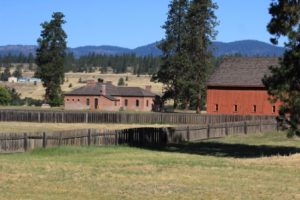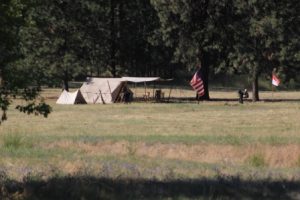A Quartermaster’s stable, brick Guard house/cells and powder house are all that remain of the structures that comprised Ft. Spokane in the 1890s. A trail meanders across the grounds with signs interpreting old foundation sites and land use. It is interesting but a bit unexciting.
Guard house/cells and powder house are all that remain of the structures that comprised Ft. Spokane in the 1890s. A trail meanders across the grounds with signs interpreting old foundation sites and land use. It is interesting but a bit unexciting.  It all comes to life when we meet two fellows from the 2nd Cavalry (re-enactors of course) who share stories of the time. The tiny camp is chocked full of vintage firearms, tack, and camp gear along with replicas painstakingly researched and created by hand. We linger to hear it all until the next group shows up and we have to move on. At the visitor center, the ranger is equally enthusiastic and filled with stories about the fort and the area geology.
It all comes to life when we meet two fellows from the 2nd Cavalry (re-enactors of course) who share stories of the time. The tiny camp is chocked full of vintage firearms, tack, and camp gear along with replicas painstakingly researched and created by hand. We linger to hear it all until the next group shows up and we have to move on. At the visitor center, the ranger is equally enthusiastic and filled with stories about the fort and the area geology.
Why a fort here? Geology. The great ice age floods (sound familiar?) created this channeled scabland but the region along the west side of the Columbia River was protected from that powerful erosion. Top soil and all that grew here were spared. The result, great crop land. It was designated an Indian Reservation making it off limits to white settlers. Settlers squatted and Indians protested. Ft Spokane was built to house troops to protect the Indians and their rights from the settlers. Sort of a turn around from most interactions.
Ironic – and pretty sad
Once troops were no longer needed and the fort abandoned it was given to the Bureau of Indian Affairs who promptly made it an Indian boarding school. They forcibly removed young Indian kids from their families to be “educated” and stripped of their cultural ties. Assimilated. What a reversal in roles for this piece of property.
